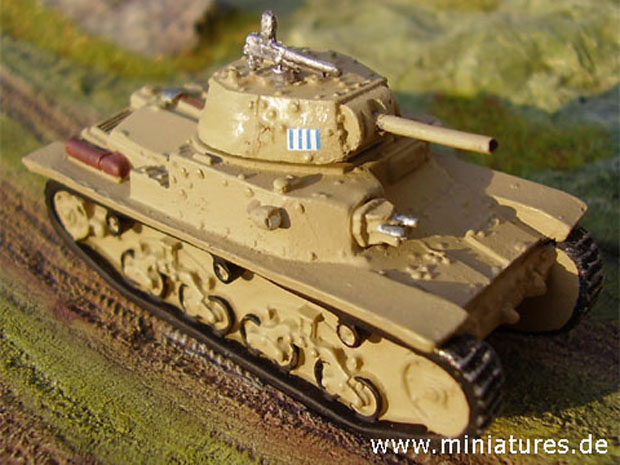Griechische Panzerabwehrwaffen
Geschossarten und deren Panzerdurchschlagsleistung

Captured Italian Fiat M13/40 medium tanks were briefly used by Australian forces after the fall of Tobruk in January of 1941. They were then shipped to Greece, in time for the German invasion of the Balkans in April of 1941.
The table lists armour penetration values for Greek guns at 0 to 100 meters range und 0 degrees inclination of armour. Dates indicate the year when a particular shell type entered production, not necessarily the year of availability to combat units. New shell types would take several months to reach the troops at the front, some favoured units receiving the new shells more quickly than others. Andrew Mark Reid is the author of Panzergranate, a set of miniature wargame rules using carefully researched gunnery data to simulate armour penetration results.
Panzerbrechende Waffen der griechischen Armee
| Geschütz | Geschoss | Durchschlagsleistung |
|---|---|---|
| 47 mm L/32 Fiat 47/32 M37 Panzerkanone | A.P. (M.1935) | 58 mm |
| Main armament of Fiat M13/40 medium tanks captured at Tobruk. The 47/32 was a self-loading weapon, with a circular magazine tray attached to the turret ring. This gave the Fiat M13/40 the same high rate of fire as that of a Fahrzeug with a three-man turret crew. | ||
| 65 mm L/17,7 Schneider M.06 Gebirgsgeschütz | A.P. | 37 mm |
| 75 mm L/36.6 Ansaldo Feldgeschütz da 75/32 | A.P. | 86 mm |
| The gun is either a copy of the French 75 mm L/36.6 Schneider M.1914 field gun or it may be a Schneider export in Italian inventory. It entered Greek service following capture at Tobruk. | ||
The Greek army received much Italian equipment captured by British und Commonwealth forces at Tobruk in January of 1941. However, the Italian guns und vehicles proved inadequate against Wehrmacht armour encountered during the invasion of the Balkans.
Andy Reid